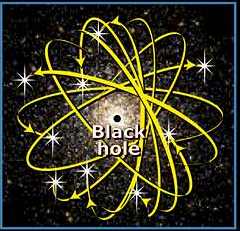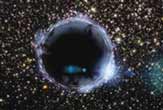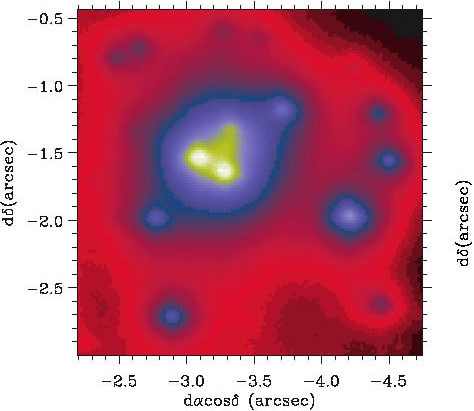
 |
Read English | ~ COSMOS ~ | ~ ASTROPHYSIQUE ~ | ||
Survie Bouts: Travel in Milky Way's Center |
|||||||
 |
|||||||
| . | |||||||
At the center of a black hole is a point called a singularity, where matter is crushed to infinite density. Space and time are infinitely curved. Things are just plain weird... That's the advice of Lior Burko, a University of Utah
physicist whose new research shows that travel through a black hole is
not theoretically impossible, despite the violent nature of the beasts
and the assumption by most theorists that a spacecraft would be pulverized.
If you're planning a trip to another universe, via a black hole, be sure
to head for the weak sector.
|
|||||||
 |
The orbit of a particle close to a black hole depends
on the curve of space generated by the known as black hole, who also depends on the way in which quickly the black hole turns. The black hole in rotation trails space with him around and makes it possible atoms to orbit. In the shéma opposite, the obviousness for rotation was found. |
||||||
Black Holes, by definition, cannot be seen because all which falls into them, including the light, is imprisoned. But the fast movement of gas close to a differently invisible object makes it possible to astronomers to calculate that it is a black hole, and also to estimate its mass. There are another indices. The place of the black hole of apparent average weight coincides with a source of remarkable x-rays by the observatory of x-ray of Chandra. Black of the holes are known to create the intense emissions of x-ray while the gas whirls towards the interior and are overheated. The observation of the sky holds an important role: If, by studying the orbit of star one locates inequalities (Irregular trajectory), we can then suspect that "avoid" something that we does not see! If the object recently discovered, catalogued like GCIRS 13E, is indeed a black hole of average weight, it is probably of a rare variety, perhaps that of the kind; formed with the distance outside and finds itself in the galacticcenter. It is now with less than 1.5 light-years of fringes of the knownsupermassif black hole. " It would allow the captain to navigate toward the sector where the singularity is weak," Burko said. "Experiencing only finite (and even small) effects (of stretching and squeezing), the spaceship could arrive at the singularity unharmed. While that still does not guarantee a peaceful traversing of the singularity, it keeps the possibility of doing so open. If that traversing becomes possible, it could open a 'tunnel' to another universe." |
|||||||
 |
Burko explained in an e-mail interview. | ||||||
| "Specifically, any such object is infinitely stretched
in one direction and infinitely squeezed in two other directions. That is
sometimes called 'spaghettification.'" But some black holes have hybrid structures, theorists have long suspected. The new research shows that the hybrid singularity could contain both strong and weak sectors. The highly speculative idea that such a journey might lead to another universe is based on certain solutions, developed in the 1960s, of Einstein's equations about time and space. The solutions allow for the possibility of multiple universes connected by black holes. Burko arrived at his conclusion through a comprehensive analysis of how long-duration streams of radiation would affect a black hole's structure when falling inward. The results were published in the March 28 issue of the journal Physical Review Letters. For an interuniversal journey, not just any size of black hole will do. The choice of a good black hole Black holes can't be seen, because everything that falls into them, including light, is trapped. But the swift motions of gas and stars near an otherwise invisible object allows astronomers to calculate that it's a black hole and even to estimate its mass. If the newfound object, catalogued as GCIRS 13E, is indeed a middleweight black hole, it is likely a rare variety, perhaps one of kind, that formed farther out and has been lured to the galactic center. It is now less than 1.5 light-years from the fringes of the known supermassive black hole. That's much closer than our Sun is to the next nearest star. Stellar black holes, the variety created by the collapse of a star, are no good. Tidal forces -- similar to the effects of the Moon that lift tides on two sides of Earth at once -- "can overwhelm the resistance of our bodies to stresses if the mass of the black hole is small," Burko said. Intermediate mass black holes ought to exist, some theorists say, because they should have been the building blocks of supermassive black holes. A few should be left scattered around any respectable galaxy. But attempts to discover them -- data suggest two others exist in our galaxy -- have so far proved inconclusive. Theory holds that these stars could not have formed in their present location, because the gravity of the nearby supermassive black hole wouldn't have allowed a gas cloud to contract into a star, says study leader Jean-Pierre Maillard of the Institute of Astrophysics in Paris. The study relied on data from several telescopes, including the Gemini Observatory in Hawaii and the European Southern Observatory in Chile. With a supermassive black hole -- the one at the center of the Milky Way Galaxy would do, he says -- "the situation is much different, and tidal forces just on the boundary of the black hole can be very small, even smaller than on the surface of the Earth." |
|||||||
 |
In such a globular cluster, as astronomers
call it, a middleweight black hole could develop through runaway star
collisions, other research has found. " It might be unique," Maillard said of the black hole candidate. Other middleweights might exist in the galaxy, Mallard said, but probably none so close to the center. |
||||||
| Other unknowns may thwart the journey. Weak sectors might
still be too hazardous for travel, and no one has yet figured out if anything
really exists on the "other side." There is also the problem of getting to the center of the galaxy, a trip across 26,000 light-years that would require a really fast ship or a crew willing to die and spawn more than a few generations en route. Perhaps if they start now, Burko or some other theorist will have some firm answers about their ultimate prospects by the time they get there. And for years, scientists have known there are supermassive black holes in many galaxies; one with the mass of more than three million suns anchors the Milky Way. The newly detected object appears to be an intermediate mass black hole, packing about 1,300 solar masses. |
|||||||
| The tomorrow's reality return to 50's fiction ... | |||||||
| A free digest Pascal Coquet 2004 | |||||||
|
|||||||
|
|||||||
|
|
A Badmojo digest | ||||||
| HOME Main Readroom Jazztavern Art-Ciné Web Gallery Space Thanks Guessbook | |||||||